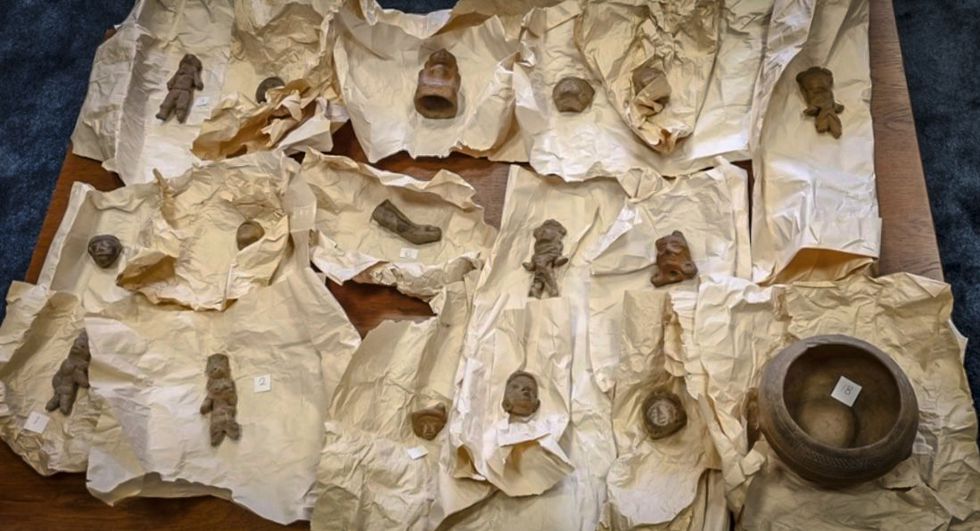Prehispanic artifacts are being brought back home! Over the decades, Mexico’s battle against prehispanic auctioning has become more and more preeminent. The country has managed to get back many artifacts and valuable pieces from its own heritage. The return of some of the prehispanic treasures adds up to more than 5,800 valuable pieces in the last three years. Just to mention some, last year, German citizens voluntarily gave back 34 pre-Hispanic pieces to the Mexican Embassy. In the summer of that same year, Italian authorities suspended the auction of 17 Mexican pieces due to the Mexican Government's demands.
This is just to mention a few of Mexico’s big successes in bringing back home invaluable pieces from different civilizations such as Mayan, Toltec, Aztec, Huasteco, and others.

Mexico started off the year with the recovery of 17 prehispanic pieces that were held in a Museum in Holanda. It all started as an exhibit of the Aztec culture at the Ethnography Museum of Leiden, on the Western side of the Netherlands. This exhibition moved Hubert De Boer and Liesebeth Mellis to bring back to Mexico 17 archaeology pieces that they held in their power for over three decades. The National Institute of Anthropology and History (INAH) in Mexico, has dictated that the clay vessels were, in the majority, of Huasteco origin.

Coming back to the American continent, the US government recently gave back at least 79 archaeological pieces and 2 paleontological pieces too, that are part of the Cultural Heritage of Mexico.
This voluntary exchange was held this past month on June 8th. It was noted that within the pieces, there were objects that belonged to the Maya Culture, Zapoteca, Teotihuacan, and other cultures from the center of the country.
As representatives of the US, citizens Rashel Mereness and Bill Lewis were in charge of giving the artifacts through the Los Angeles Embassy. Canciller Marcelo Ebrard was then in charge of receiving the objects as a representative of the INAH.
The INAH emphasized that the paleontological goods are two plates with fossil impressions of fish, in a format of cut slabs, which are specimens of the order Clupeomorpha, coming from Mexican territory, and a Mayan style tripod vase from the Classic Mesoamerican period (400-900 A.D.). It is made of modeled, polished, and molded clay.
It is worth mentioning that the objects will be delivered and distributed to the corresponding authorities, in this case, the Ministry of Culture and INAH, for their proper safekeeping, analysis, and conservation, as reported in La Verdad Noticias.
The Mexican Foreign Minister reaffirmed his commitment to actively participate in the strengthening of national and international legal frameworks, in order to protect the country's cultural heritage, in addition to collaborating with the US government to prevent the illicit trafficking of cultural property, in order to recover unique pieces found in the illegal market abroad.

More recently, on July 11th, 19 boxes came into the country. These boxes came in anonymously from Spain and held over 2,000 prehispanic pieces within, 2. Now, 1,371 of the objects are held under INAH custody in the Templo Mayor Museum.
The INAH official commented that the heritage was already identified in a "preliminary way" by the staff of the Mexican consulate general in Barcelona, with the management of the consul Claudia Pavlovich and with the "very outstanding" intervention of the Mexican archaeologist Anna Goycoolea Artís, cultural manager of the consulate. It was also said that "The great majority of the pieces come from the Basin of Mexico and correspond to the Mexica culture". The objects are exhibited from Tuesday in the lobby of the Templo Mayor Museum.
The recovered pieces correspond to what archaeologists consider the Aztec III complex; some others correspond to the Texcocan culture. "We found a very clear stratigraphy of all the cultural stages in the Basin of Mexico. There are classic objects, from the first centuries before our era, up to the third century of our era.
Figures of horsemen riding horses speak to us of the enormous curiosity that the Mexica, inhabitants of the basin of Mexico, had for the topic of the equestrian figures.
The Mexican Foreign Minister reaffirmed his commitment to actively participate in the strengthening of national and international legal frameworks, in order to protect the country's cultural heritage, in addition to collaborating with the U.S. government to prevent the illicit trafficking of cultural property, to recover unique pieces found in the illegal market abroad.
Mexico, like other countries, is raising up against auctioning prehispanic pieces and other artifacts with historical, cultural, or artistic value. As these objects are part of the national culture and heritage. This has concerned many in recent years due to recent auctions being held in European countries.
Learn more about it in this article from El País, here.